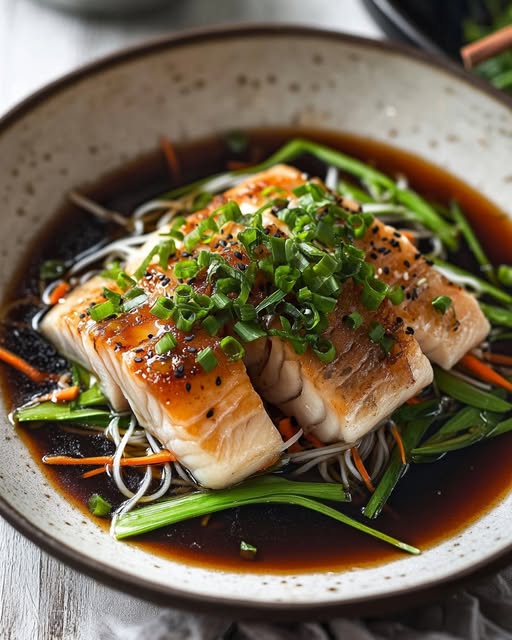Why This Steamed Ginger Fish Recipe Will Win Your Heart
I remember the first time I tried Steamed Ginger Fish. It was at a tiny Asian restaurant tucked away in a quiet corner of the city. The aroma of ginger, garlic, and soy sauce hit me as soon as I walked in. The dish was light, flavorful, and felt like a warm hug. When I recreated it at home, I couldn’t believe how easy it was. Now, this recipe has become my go-to for busy weeknights or when I want to impress friends without spending hours in the kitchen.
The Story Behind Steamed Ginger Fish
This dish is rooted in Asian cuisine, where steaming is a popular cooking method. It’s simple yet elegant, allowing the natural flavors of the ingredients to shine. Traditionally, families would use whole fish, but modern versions often call for filets to make prep easier. I love how this dish bridges tradition and convenience. Plus, it’s perfect for anyone who wants to eat healthier without sacrificing taste.
Why You’ll Love This Recipe
Steamed Ginger Fish is a winner for so many reasons. First, it’s incredibly quick—ready in just 30 minutes. Second, it’s packed with flavor thanks to the aromatic ginger, garlic, and soy sauce. Third, it’s versatile. Serve it with rice, noodles, or even on its own for a lighter meal. And let’s not forget how healthy it is. The gentle steaming method preserves the nutrients in the fish, making it a guilt-free indulgence.
Perfect Occasions to Make Steamed Ginger Fish
This dish is perfect for casual dinners, date nights, or even potlucks. I’ve served it at dinner parties and watched as guests went back for seconds (and thirds). It’s also great for busy weekdays when you want something nutritious but don’t have hours to cook. Plus, the presentation is so beautiful that it feels special enough for holidays like Lunar New Year or Thanksgiving.
Ingredients for Steamed Ginger Fish
- For the fish:
- 340-400 g of white fish fillet with skin
- 2 teaspoons sesame oil
- 1/8 teaspoon salt
- 1/8 teaspoon pepper
- 4 cm piece of ginger, julienned
- 4-5 green onions, cut into short julienne strips
- 1 small onion, thinly sliced
- 1/2 medium carrot, julienned
- For the sauce:
- 1 tablespoon olive oil
- 2 small shallots, chopped (optional)
- 2-3 garlic cloves, minced
- 1/2 teaspoon minced ginger
- 1 1/2 – 2 tablespoons soy sauce
- 1/8 teaspoon salt (optional)
- 1/8 teaspoon pepper
Substitution Options
If you can’t find white fish, try salmon or cod—they work beautifully. Swap sesame oil with vegetable oil if needed. For a gluten-free version, use tamari instead of soy sauce. You can also replace green onions with leeks for a milder flavor. Feel free to add mushrooms or bok choy for extra texture and nutrients.
Step 1: Prepare the Fish
Start by placing your fish fillet in a shallow dish suitable for steaming. Drizzle it with sesame oil and sprinkle lightly with salt and pepper. Gently massage these seasonings into the fish to ensure even coverage. This step not only seasons the fish but also helps lock in moisture during cooking. Pro tip: Use fresh, high-quality fish for the best results.
Step 2: Prep the Aromatics
While the fish rests, peel and julienne the ginger, carrots, and green onions. Finely chop the garlic, shallots, and a small piece of ginger for the sauce. These vibrant veggies not only add color but also infuse the dish with layers of flavor. Imagine the bright orange of carrots against the pale green of onions—it’s almost too pretty to eat!
Step 3: Make the Sauce
In a small pan over medium heat, warm the olive oil. Add the chopped shallots and garlic, stirring until fragrant. Toss in the minced ginger and cook briefly until aromatic. Pour in the soy sauce, then season with pepper and a pinch of salt. Let it simmer for a few seconds before transferring to a bowl. This sauce is the soul of the dish, so take your time here.
Step 4: Steam the Fish
Layer the ginger, green onions, carrots, and onions on top of the fish. Cover the dish with aluminum foil and place it in your steamer. Steam for 8-9 minutes. Watching the steam rise and smelling the aromas is one of my favorite parts—it’s like a little preview of the deliciousness to come.
Step 5: Finish and Garnish
Remove the foil, pour the sauce over the fish, and garnish with more green onions. Return the dish to the steamer uncovered and cook for another 4-6 minutes. The fish should flake easily with a fork when done. Serve hot with rice and maybe a sprig of cilantro for flair.
Chef’s Tip
To elevate your Steamed Ginger Fish, drizzle a bit of chili oil over the top before serving. It adds a subtle kick that pairs beautifully with the savory soy sauce.
Timing Breakdown
- Prep Time: 15 minutes
- Cooking Time: 15 minutes
- Total Time: 30 minutes
Chef’s Secret
Always pat the fish dry with paper towels before seasoning. Excess moisture can prevent the flavors from penetrating the fish properly.
Extra Info
Did you know that ginger has been used in Chinese medicine for centuries? It’s believed to aid digestion and boost immunity. No wonder this dish feels so nourishing!
Necessary Equipment
- Steamer basket or steamer pot
- Shallow heatproof dish
- Small saucepan
- Knife and cutting board
Storage Tips
Store leftovers in an airtight container in the fridge for up to two days. Reheat gently in the microwave or on the stovetop to avoid drying out the fish. Avoid freezing, as the texture may change upon thawing.
If you have extra sauce, keep it separate and drizzle it over the reheated fish for freshness. Never store raw and cooked ingredients together to prevent cross-contamination.
For meal prep enthusiasts, you can pre-cut all the vegetables and store them in ziplock bags. This saves time during busy weekdays.
Tips and Advice
Use a timer to avoid overcooking the fish. Patience is key; resist the urge to peek while steaming. Fresh ingredients always yield better results than dried ones.
Presentation Ideas
- Serve on a bed of fluffy jasmine rice.
- Garnish with edible flowers for elegance.
- Use colorful plates to highlight the dish’s vibrancy.
Healthier Alternatives
- Low-Sodium Version: Use low-sodium soy sauce and skip added salt.
- Vegan Option: Replace fish with tofu or tempeh.
- Keto-Friendly: Skip the rice and pair with cauliflower mash.
- Spicy Twist: Add red chili flakes to the sauce.
- Herb Lover’s Dream: Mix in fresh cilantro or basil.
- Lemon Zest Boost: Sprinkle lemon zest for brightness.
Mistake 1: Overcooking the Fish
Fish cooks quickly, especially when steamed. Overcooking turns it rubbery and ruins the delicate texture. To avoid this, check for doneness after 8 minutes. The fish should flake easily but still look moist. Tip: Use a fork to test tenderness.
Mistake 2: Skipping the Aluminum Foil
Covering the fish with foil traps steam, ensuring even cooking. Without it, the top might remain undercooked while the bottom gets mushy. Always cover during the initial steaming phase.
Mistake 3: Using Stale Ingredients
Fresh ginger and garlic make a world of difference. Old spices lack potency and can dull the dish’s flavor profile. Invest in fresh produce for maximum impact.
Mistake 4: Not Patting the Fish Dry
Excess water prevents proper seasoning absorption. Always pat the fish dry with paper towels before adding oils and spices.
Mistake 5: Rushing the Sauce
The sauce needs time to develop depth. Don’t rush the sautéing process. Let the aromatics bloom fully before adding soy sauce.
Can I Use Frozen Fish?
Yes, but thaw it completely first. Frozen fish releases excess water during steaming, which can dilute flavors. Thaw overnight in the fridge for best results.
What Type of Fish Works Best?
White fish like tilapia, cod, or snapper are ideal. They’re mild and absorb the flavors of the sauce well. Avoid oily fish like mackerel, which can overpower the dish.
Is This Dish Gluten-Free?
It can be! Simply swap regular soy sauce with tamari. Double-check other ingredients to ensure they’re gluten-free.
How Do I Know When the Fish Is Done?
The fish will turn opaque and flake easily with a fork. If it still looks translucent in spots, give it another minute or two.
Can I Add Vegetables to the Dish?
Absolutely! Bok choy, mushrooms, or snap peas complement the flavors beautifully. Just layer them alongside the fish.
What Rice Pairs Well?
Jasmine or basmati rice works wonderfully. For a healthier option, try brown rice or quinoa.
Can I Make This Ahead?
You can prep the ingredients ahead, but assemble and steam just before serving. This ensures optimal freshness and texture.
Why Does My Sauce Taste Bland?
You might need more soy sauce or ginger. Taste and adjust seasonings as needed. Freshly grated ginger offers stronger flavor than powdered.
How Long Can I Store Leftovers?
Keep leftovers refrigerated for up to two days. Reheat gently to preserve the fish’s texture.
Can I Freeze This Dish?
Freezing isn’t recommended, as the fish may become watery upon thawing. Enjoy it fresh for the best experience.
What If I Don’t Have a Steamer?
No problem! Use a colander placed over a pot of boiling water, covered with a lid. Just make sure the colander doesn’t touch the water.
There you have it—a complete guide to mastering Steamed Ginger Fish. Whether you’re cooking for yourself or hosting a dinner party, this dish promises to delight. So grab your ingredients, fire up the steamer, and get ready to fall in love with this simple yet stunning recipe. Happy cooking!

Steamed Ginger Fish
Ingredients
Equipment
Method
- Place the fish fillet in a shallow dish, drizzle with sesame oil, and season with salt and pepper.
- Peel and julienne the ginger, carrots, and green onions; chop garlic and shallots for the sauce.
- In a small pan, heat olive oil and sauté shallots and garlic until fragrant; add minced ginger and soy sauce, then season with pepper and salt.
- Layer ginger, green onions, carrots, and onions on top of the fish in the shallow dish.
- Cover with aluminum foil and steam for 8-9 minutes.
- Remove foil, pour sauce over the fish, garnish with more green onions, and steam uncovered for another 4-6 minutes.
